
The Reichskonkordat is a treaty negotiated between the Vatican and the emergent Nazi Germany. It was signed on 20 July 1933 by Cardinal Secretary of State Eugenio Pacelli, who later became Pope Pius XII, on behalf of Pope Pius XI and Vice Chancellor Franz von Papen on behalf of President Paul von Hindenburg and the German government. It was ratified 10 September 1933 and it has been in force from that date onward. The treaty guarantees the rights of the Catholic Church in Germany. When bishops take office Article 16 states they are required to take an oath of loyalty to the Governor or President of the German Reich established according to the constitution. The treaty also requires all clergy to abstain from working in and for political parties. Nazi breaches of the agreement began almost as soon as it had been signed and intensified afterwards leading to protest from the Church including in the 1937 Mit brennender Sorge encyclical of Pope Pius XI. The Nazis planned to eliminate the Church's influence by restricting its organizations to purely religious activities.

Mit brennender SorgeOn the Church and the German Reich is an encyclical of Pope Pius XI, issued during the Nazi era on 10 March 1937. Written in German, not the usual Latin, it was smuggled into Germany for fear of censorship and was read from the pulpits of all German Catholic churches on one of the Church's busiest Sundays, Palm Sunday.

Clemens Augustinus Emmanuel Joseph Pius Anthonius Hubertus Marie Graf von Galen, better known as Clemens August Graf von Galen, was a German count, Bishop of Münster, and cardinal of the Roman Catholic Church. During World War II, Galen led Catholic protest against Nazi euthanasia and denounced Gestapo lawlessness and the persecution of the Church in Germany. He was appointed a Cardinal by Pope Pius XII in 1946. He was beatified by Pope Benedict XVI in 2005.

Ludwig Kaas was a German Roman Catholic priest and politician of the Centre Party during the Weimar Republic. He was instrumental in brokering the Reichskonkordat between the Holy See and the German Reich.

Erich Klausener was a German Catholic politician who was killed in the "Night of the Long Knives", a purge that took place in Nazi Germany from 30 June to 2 July 1934, when the Nazi regime carried out a series of political murders.
A census in May 1939, six years into the Nazi era and after the annexation of mostly Catholic Austria and mostly Catholic Czechoslovakia into Germany, indicates that 54% of the population considered itself Protestant, 40% considered itself Catholic, 3.5% self-identified as Gottgläubig, and 1.5% as "atheist". Protestants voted for the Nazi party substantially more than Catholics did.
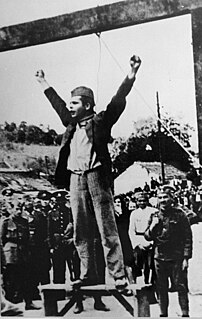
German resistance to Nazism included opposition by individuals and groups in Germany to the Nazi regime between 1933 and 1945, most of which engaged in active resistance, including attempts to remove Adolf Hitler from power by assassination or by overthrowing his established regime.

Austria under National Socialism describes the period of Austrian history from 12 March 1938 when Austria was annexed by Nazi Germany until the end of World War II in 1945.
Kirchenkampf is a German term which pertains to the situation of the Christian churches in Germany during the Nazi period (1933–1945). Sometimes used ambiguously, the term may refer to one or more of the following different "church struggles":
- The internal dispute within German Protestantism between the German Christians and the Confessing Church over control of the Protestant churches;
- The tensions between the Nazi regime and the Protestant church bodies; and
- The tensions between the Nazi regime and the Roman Catholic Church.
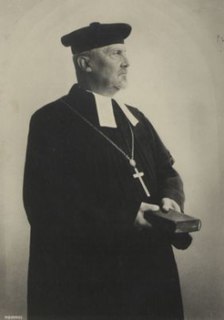
Theophil Heinrich Wurm was the son of a pastor and was a leader in the German Protestant Church in the early twentieth century.

Catholic bishops in Nazi Germany differed in their responses to the rise of Nazi Germany, World War II, and the Holocaust during the years 1933–1945. In the 1930s, the Episcopate of the Catholic Church of Germany comprised 6 Archbishops and 19 bishops while German Catholics comprised around one third of the population of Germany served by 20,000 priests. In the lead up to the 1933 Nazi takeover, German Catholic leaders were outspoken in their criticism of Nazism. Following the Nazi takeover, the Catholic Church sought an accord with the Government, was pressured to conform, and faced persecution. The regime had flagrant disregard for the Reich concordat with the Holy See, and the episcopate had various disagreements with the Nazi government, but it never declared an official sanction of the various attempts to overthrow the Hitler regime. Ian Kershaw wrote that the churches "engaged in a bitter war of attrition with the regime, receiving the demonstrative backing of millions of churchgoers. Applause for Church leaders whenever they appeared in public, swollen attendances at events such as Corpus Christi Day processions, and packed church services were outward signs of the struggle of ... especially of the Catholic Church - against Nazi oppression". While the Church ultimately failed to protect its youth organisations and schools, it did have some successes in mobilizing public opinion to alter government policies.
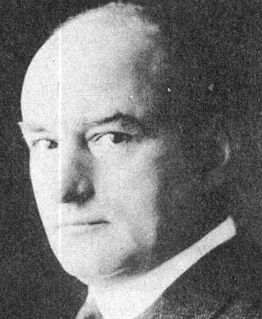
Popes Pius XI (1922–1939) and Pius XII (1939–1958) led the Catholic Church during the rise and fall of Nazi Germany. Around a third of Germans were Catholic in the 1930s, generally in southern Germany; Protestants dominated the north. The German Catholic church had opposed the Nazi Party, and in the 1933 elections, the proportion of Catholics voting for the Nazi Party was lower than the national average. Nevertheless, the Catholic-aligned Centre Party voted for the Enabling Act of 1933, which gave Adolf Hitler dictatorial powers.
During the pontificate of Pope Pius XI (1922–1939), the Weimar Republic transitioned into Nazi Germany. In 1933, the ailing President von Hindenberg appointed Adolf Hitler as Chancellor of Germany in a Coalition Cabinet, and the Holy See concluded the Reich concordat treaty with the still nominally functioning Weimar state later that year. Hoping to secure the rights of the Church in Germany, the Church agreed to a requirement that clergy cease to participate in politics. The Hitler regime routinely violated the treaty, and launched a persecution of the Catholic Church in Germany.
During the German Occupation of Poland (1939–1945), the Nazis brutally suppressed the Catholic Church in Poland, most severely in German-occupied areas of Poland. Thousands of churches and monasteries were systematically closed, seized or destroyed. As a result, many works of religious art and objects were permanently lost.

Catholic resistance to Nazi Germany was a component of German resistance to Nazism and of Resistance during World War II. The role of the Church during the Nazi years was always, and remains however, a matter of much contention. Many writers, echoing Klaus Scholder, have concluded, "There was no Catholic resistance in Germany, there were only Catholics who resisted." The Vatican policy meant that the Pope never challenged Catholics to side either with National Socialism or with Catholic morality, and Pius XII was so adamant that Bolshevism represented the most terrible threat to the world that he remarked, 'Germany are a great nation who, in their fight against Bolshevism, are bleeding not only for their friends but also for the sake of their present enemies'. In a letter of autumn 1941 Pius XII wrote to Bishop Preysing, "We emphasise that, because the Church in Germany is dependent upon your public behaviour...in public declarations you are duty bound to exercise restraint" and "requires(d) you and your colleagues not to protest."

During the Second World War, the Roman Catholic Church protested against Aktion T4, the Nazi involuntary euthanasia programme under which the mentally ill, physically deformed, and incurably sick were to be killed. The protests formed one of the most significant public acts of Catholic resistance to Nazism undertaken within Germany. The euthanasia programme began in 1939, and ultimately resulted in the murder of more than 70,000 people who were senile, mentally handicapped, mentally ill, epileptics, cripples, children with Down's Syndrome, or people with similar afflictions. The murders involved interference in Church welfare institutions, and awareness of the murderous programme became widespread. Church leaders who opposed it – chiefly the Catholic Bishop Clemens August von Galen of Münster and Protestant Bishop Theophil Wurm – were therefore able to rouse widespread public opposition.

Nazi ideology could not accept an autonomous establishment whose legitimacy did not spring from the government. It desired the subordination of the church to the state. To many Nazis, Catholics were suspected of insufficient patriotism, or even of disloyalty to the Fatherland, and of serving the interests of "sinister alien forces". Nazi radicals also disdained the Semitic origins of Jesus and the Christian religion. Although the broader membership of the Nazi Party after 1933 came to include many Catholics, aggressive anti-Church radicals like Alfred Rosenberg, Martin Bormann and Heinrich Himmler saw the kirchenkampf campaign against the Churches as a priority concern, and anti-church and anticlerical sentiments were strong among grassroots party activists.

The Roman Catholic Church suffered persecution in Nazi Germany. The Nazis claimed jurisdiction over all collective and social activity and the party leadership hoped to dechristianize Germany in the long term. Clergy were watched closely, and frequently denounced, arrested and sent to Nazi concentration camps. Welfare institutions were interfered with or transferred to state control. Catholic schools, press, trade unions, political parties and youth leagues were eradicated. Anti-Catholic propaganda and "morality" trials were staged. Monasteries and convents were targeted for expropriation. Prominent Catholic lay leaders were murdered, and thousands of Catholic activists were arrested.
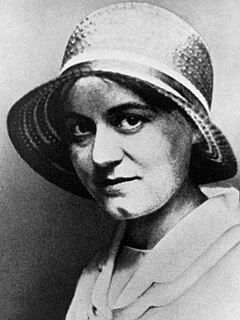
Several Catholic countries and populations fell under Nazi domination during the period of the Second World War (1939–1945), and ordinary Catholics fought on both sides of the conflict. Despite efforts to protect its rights within Germany under a 1933 Reichskonkordat treaty, the Church in Germany had faced persecution in the years since Adolf Hitler had seized power, and Pope Pius XI accused the Nazi government of sowing 'fundamental hostility to Christ and his Church'. The concordat has been described by some as giving moral legitimacy to the Nazi regime soon after Hitler had acquired quasi-dictatorial powers through the Enabling Act of 1933, an Act itself facilitated through the support of the Catholic Centre Party. Pius XII became Pope on the eve of war and lobbied world leaders to prevent the outbreak of conflict. His first encyclical, Summi Pontificatus, called the invasion of Poland an "hour of darkness". He affirmed the policy of Vatican neutrality, but maintained links to the German Resistance. Despite being the only world leader to publicly and specifically denounce Nazi crimes against Jews in his 1942 Christmas Address, controversy surrounding his apparent reluctance to speak frequently and in even more explicit terms about Nazi crimes continues. He used diplomacy to aid war victims, lobbied for peace, shared intelligence with the Allies, and employed Vatican Radio and other media to speak out against atrocities like race murders. In Mystici corporis Christi (1943) he denounced the murder of the handicapped. A denunciation from German bishops of the murder of the "innocent and defenceless", including "people of a foreign race or descent", followed.
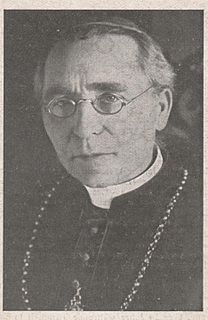
Caspar Klein was a Catholic Archbishop of Paderborn, Germany, during the Nazi era.













